Imagine strolling through a picturesque garden in the United Kingdom, with vibrant flowers blooming amidst the lush greenery. As you make your way through the garden, you come across a stunning evergreen shrub, adorned with beautiful yellow flowers that seem to brighten even the dreariest of days. This captivating plant is none other than Mahonia japonica, also known as Berberis japonica.
Mahonia japonica is a versatile and low-maintenance shrub that adds year-round beauty and interest to UK gardens. Its leathery leaves and small, bell-like yellow flowers can bloom in winter, spring, or fall, depending on the variety. And if that’s not enough, after the flowers fade away, edible blue or black berries take their place, attracting birds and adding a touch of nature to your garden.
So, let’s dive into the world of Mahonia japonica and discover how to care for this enchanting shrub in your very own UK garden.
Appearance of Mahonia Japonica


Mahonia japonica, an evergreen shrub, features leathery, prickly leaves divided into segments. It grows upright and can reach a height of 1-8ft (30cm-2m). The small, dainty, rounded yellow flowers of mahonia japonica bloom in winter, spring, or fall, depending on the variety. These flowers are gathered in clusters or arching spikes. Following the flowers, mahonia japonica produces edible blue or black berries. The foliage of mahonia japonica adds structure and texture to the garden, while the flowers and berries provide a splash of vibrant colour and visual interest.
Among its varieties, Mahonia japonica showcases diversity in growth habit and flowering times, ensuring there’s a suitable option for every garden design. Notably, the ‘Soft Caress‘ variety stands apart with its spine-free, feathery leaves, offering a softer texture and a more delicate appearance. This variety blooms with the same enchanting yellow flowers characteristic of mahonias, making it a unique and appealing choice for those seeking the beauty of mahonia without the prickliness, blending seamlessly into a variety of garden settings.
 The Mahonia Japonica is renowned for its beautiful winter flowers and its use in herbal remedies. Beyond brightening up the winter with its yellow blooms, it’s vital for bees and butterflies, providing nectar when little else is available.
The Mahonia Japonica is renowned for its beautiful winter flowers and its use in herbal remedies. Beyond brightening up the winter with its yellow blooms, it’s vital for bees and butterflies, providing nectar when little else is available.
Light Requirements for Mahonia Japonica (Berberis japonica)

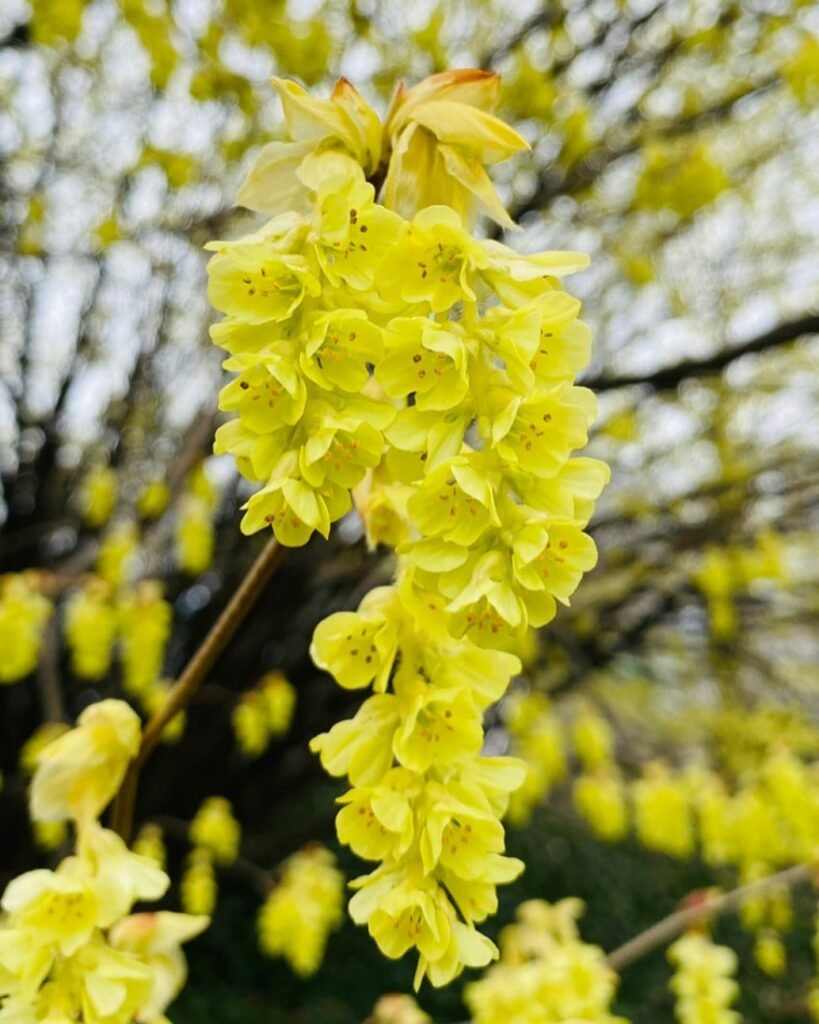
Mahonia japonica, also known as Berberis japonica, is a versatile shrub that can thrive in various light conditions. While it prefers to be grown in part shade or partial sun, it is also shade-tolerant, making it an excellent choice for gardens with limited sunlight. When provided with some direct or indirect sunlight, mahonia japonica performs at its best, ensuring optimal growth and flowering.
It is important to consider the specific light requirements of the variety of mahonia japonica you are planting. Some varieties may tolerate full shade, while others may require a bit more sunlight. By understanding the light preferences of the specific mahonia japonica variety, you can ensure that the plant receives the ideal light conditions for its growth and development.

Watering Tips for Mahonia Japonica
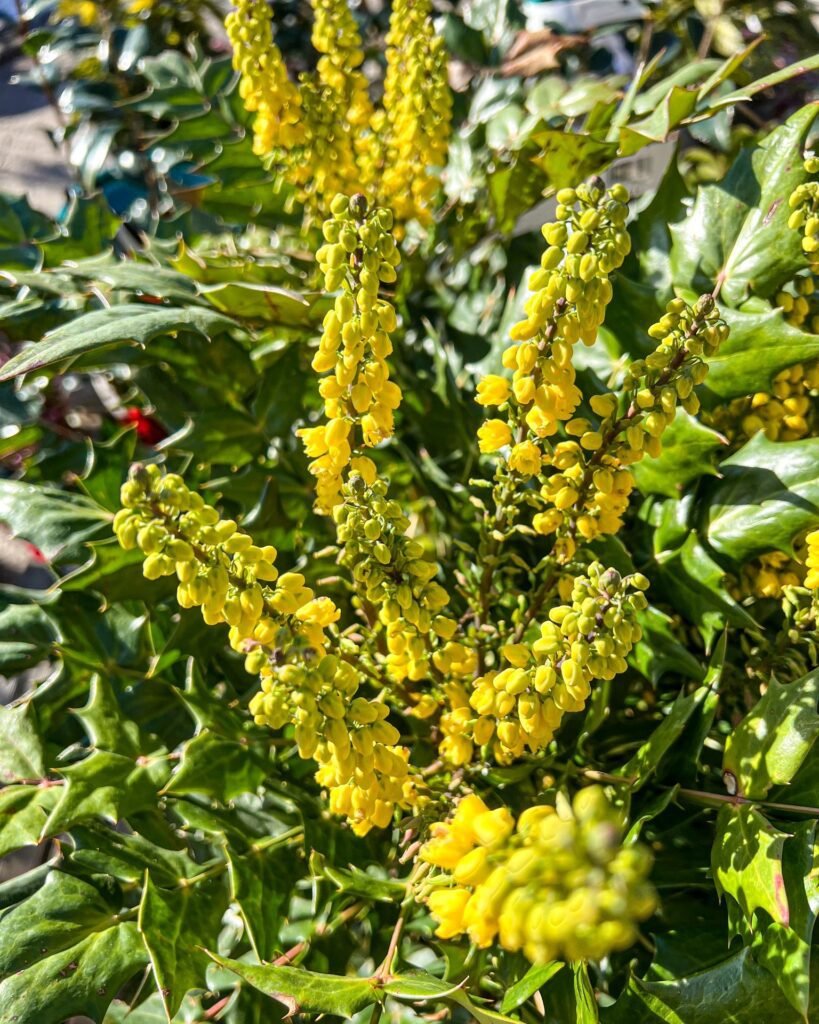
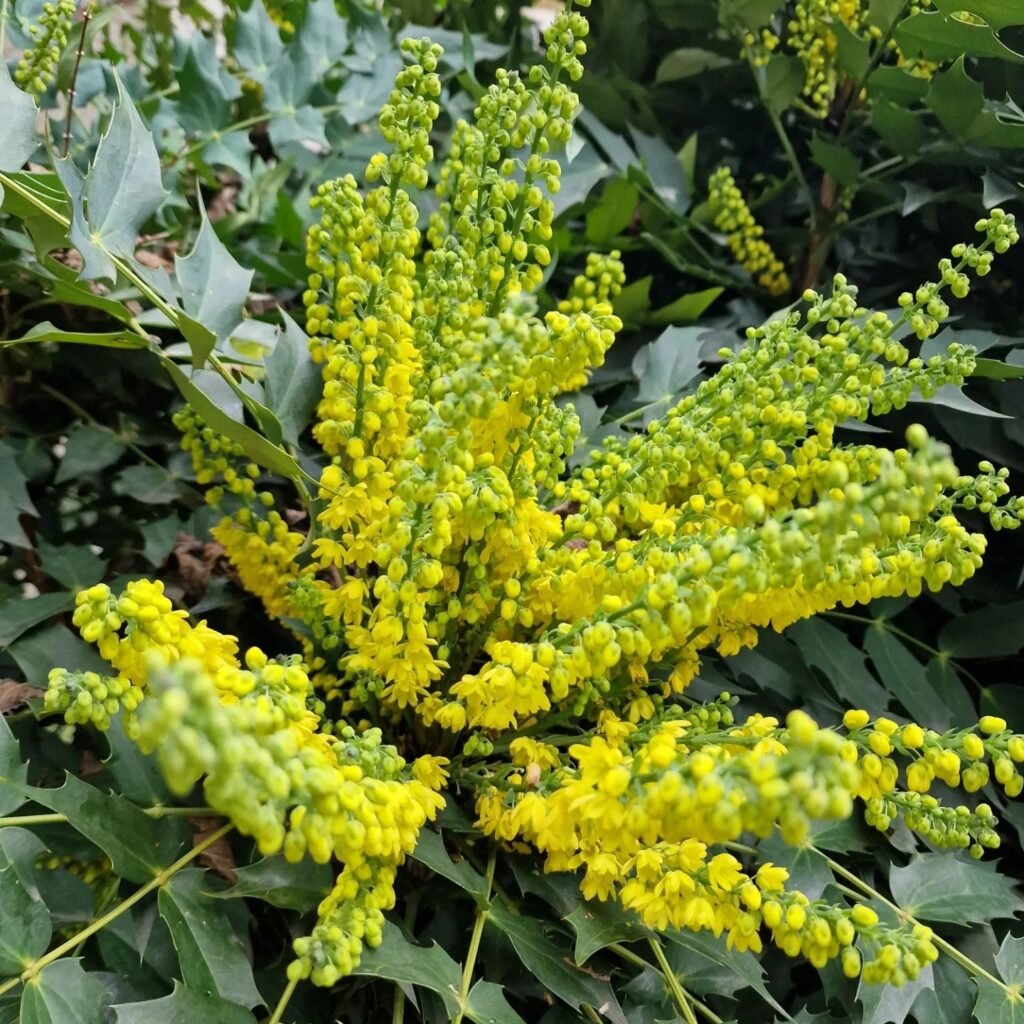
Mahonia japonica, also known as Berberis japonica, requires regular watering to thrive in your UK garden. This versatile evergreen shrub has moderate water needs and performs best in moist, well-drained soil. To ensure optimal growth and vibrant flowering, it is important to follow these watering tips:
- Water regularly: Mahonia japonica should be watered regularly, especially during dry periods, to keep the soil consistently moist. Pay attention to the weather conditions and adjust your watering schedule accordingly.
- Avoid overwatering: While it is important to keep the soil moist, overwatering can lead to root rot and other issues. Make sure not to let the plant sit in waterlogged soil.
- Mulch around the base: Applying a layer of mulch around the base of the plant can help retain moisture in the soil, reducing water evaporation and maintaining a more consistent soil moisture level.
- Establishment phase: During the establishment phase, which is the period when the plant is getting established in its new location, it is particularly important to provide regular watering to promote healthy growth and root development.

Fertilizing and Soil for Mahonia Japonica


When it comes to the soil requirements for Mahonia Japonica, it thrives best in moist, well-drained soil. The soil should ideally have a slightly acidic, neutral, or alkaline pH. Good news is, this adaptable shrub can tolerate a wide range of soil types, including chalky soils. However, to enhance its growth and fertility, it’s beneficial to amend the soil before planting.
Incorporating organic matter, such as peat-free compost, into the soil helps improve its structure and fertility. This amendment allows for better water drainage and nutrient uptake by the plant. Prepare the soil by digging in the organic matter, mixing it well with the existing soil for even distribution.
Best Soil for Mahonia Japonica
Based on its preferences, the best soil for Mahonia Japonica is a moist, well-drained soil with the mentioned pH ranges. Whether the soil is slightly acidic, neutral, or alkaline, it suits the adaptability of this versatile shrub. Remember to avoid waterlogged soil, as it can cause root rot and other issues.
Berberis Japonica Fertilizer
While Mahonia Japonica is relatively low-maintenance and doesn’t require heavy fertilization, a general-purpose slow-release fertilizer can be applied in spring to provide the necessary nutrients for healthy growth. This type of fertilizer releases nutrients gradually, ensuring a consistent supply throughout the growing season. It’s important to follow the manufacturer’s instructions regarding application rates and timing.
In addition to using slow-release fertilizer, organic matter amendments like peat-free compost also contribute to the plant’s nutrient requirements. The decomposed organic material enriches the soil with nutrients, promoting healthy growth and vibrant blooms.

Pruning and Maintenance for Mahonia Japonica

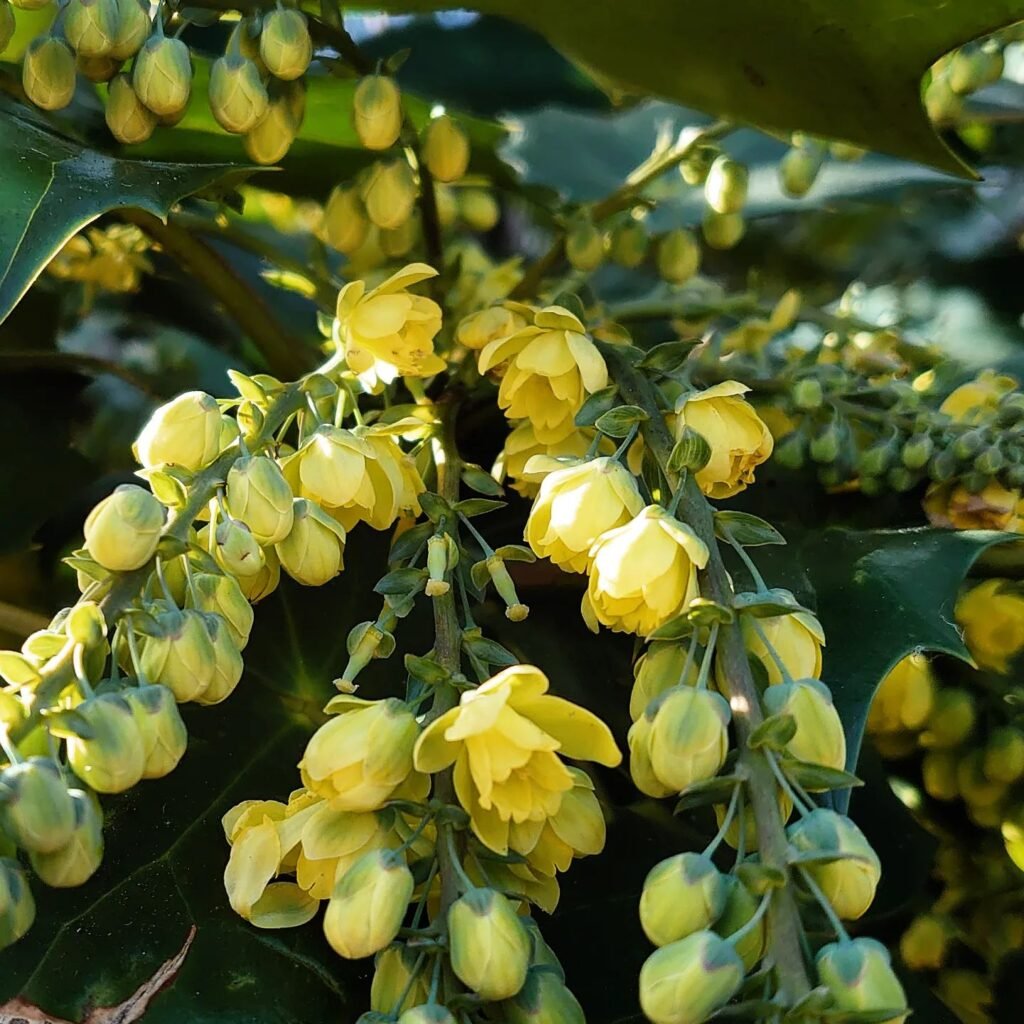
Mahonia japonica is a relatively low-maintenance plant that requires minimal pruning. However, a few maintenance tasks can help keep your plant healthy and ensure its optimal growth:
1.Light Pruning:
After flowering, you can do light pruning to maintain the shape of your mahonia japonica and remove any dead or damaged branches. This will help the plant maintain its desired form and promote healthy growth.
2.Drastic Pruning:
If your mahonia japonica becomes leggy or bare at the base, a more extensive pruning can be done in spring. This will encourage fresh growth from the base and rejuvenate the plant for the upcoming season.
3.Deadheading:
Regular deadheading of faded flowers can help promote continuous blooming. Simply remove the faded blooms to encourage the plant to produce more flowers, extending its flowering period.
4.Maintenance:
Keep the soil consistently moist by watering your mahonia japonica regularly, especially during dry periods. Mulching around the base of the plant can help retain moisture and suppress weed growth. Regular monitoring for signs of pests or diseases will ensure early detection and appropriate action if needed.
Remember, mahonia japonica is a relatively low-maintenance plant, but proper care and maintenance will help it flourish and enhance the aesthetic appeal of your garden.
- Tip: Pruning and maintenance should be carried out with caution to avoid any harm to yourself or the plant. Use suitable tools and follow proper pruning techniques.
- Tip: Consider wearing garden gloves to protect your hands from the spiky leaves of mahonia japonica during pruning or maintenance tasks.

Propagating Mahonia Japonica (Berberis japonica)


Mahonia japonica, also known as Berberis japonica, is a beautiful evergreen shrub that can be propagated through various methods. Whether you choose division, stem cuttings, or seed propagation, providing the right care and conditions is essential for successful establishment.
Division
Propagating Mahonia japonica through division can be done in spring or autumn. Carefully separate the rhizomes or rootball into smaller sections and replant them. By dividing the plant, you can create new individuals and expand your mahonia japonica collection.
Stem Cuttings
Stem cuttings can be taken in summer when the plant is actively growing. Choose healthy, non-flowering shoots and cut them just below a leaf node. Remove the lower leaves, leaving a few at the top for photosynthesis. Root the cuttings in a well-draining medium, such as a mixture of perlite and peat moss. Keep the cuttings consistently moist and provide them with indirect sunlight. After a few weeks, they should develop roots and can be transplanted into individual pots.
Seed Propagation
Mahonia japonica can also be propagated from seeds, although this method may take longer before the plant reaches maturity. Collect ripe berries from the plant and extract the seeds. It is important to remove the fleshy coating around the seeds to promote germination. Sow the seeds in a pot filled with a well-draining seed-starting mix, lightly pressing them into the soil. Water the pot and cover it with a plastic bag or a propagator to create a humid environment. Place the pot in a warm location with indirect light. The seeds should germinate within a few weeks. Once they have developed several sets of leaves, they can be transplanted into individual pots or directly into the garden.
Propagating Mahonia japonica allows you to expand your garden with new plants and enjoy the beauty of this versatile shrub. Whether you choose division, stem cuttings, or seed propagation, following these methods will help you successfully propagate and establish new mahonia japonica plants.

Repotting Tips for Mahonia Japonica
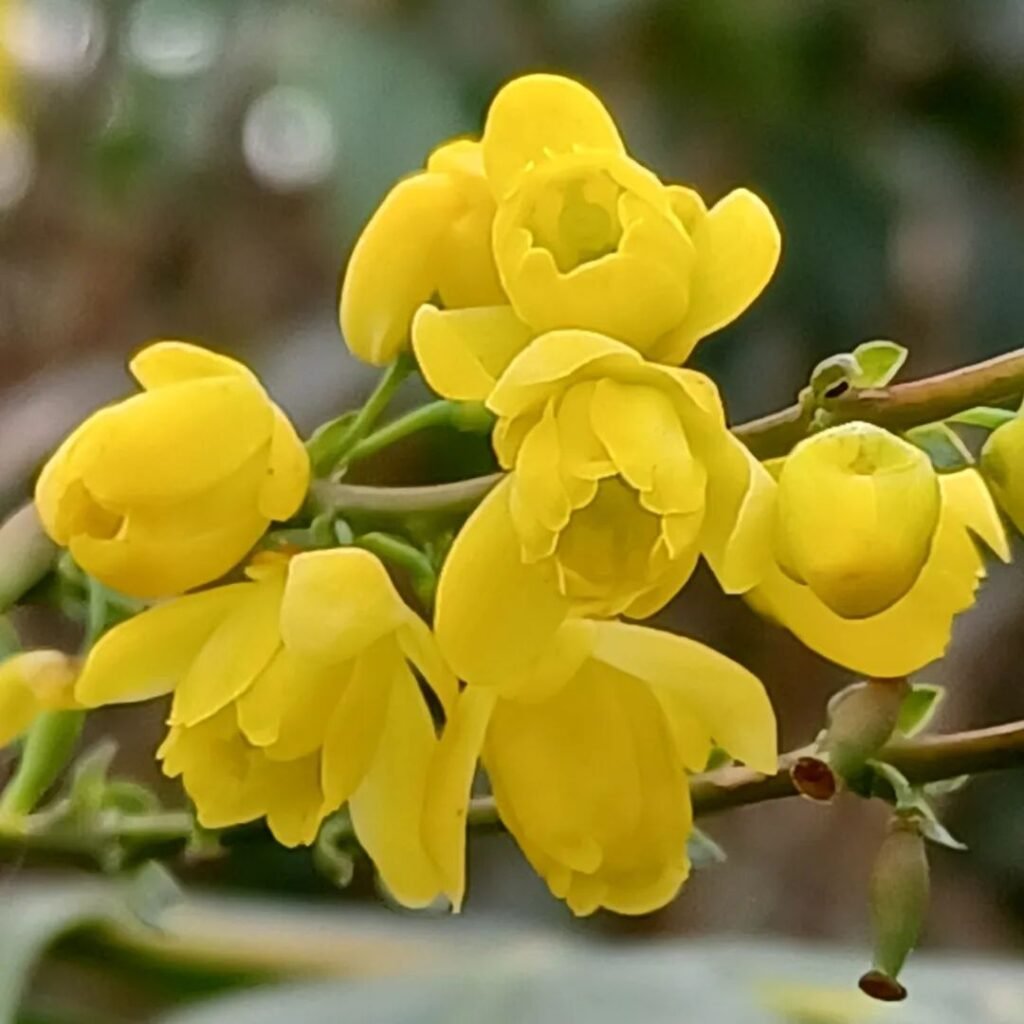

Mahonia japonica can be a versatile addition to small gardens or patio spaces as it can be grown in containers. When repotting this evergreen shrub, it’s important to follow a few key tips to ensure its health and successful growth.
- Choose a container with good drainage holes to prevent waterlogging, as excess moisture can lead to root rot and other issues.
- Use a well-draining potting mix that is slightly acidic to neutral in pH. This will provide the right growing conditions for mahonia japonica.
- Carefully remove the plant from its current container, taking care not to damage the roots.
- Place the plant in the new container, ensuring that the top of the plant is level with the soil.
- Backfill the container with the potting mix, firming it gently around the plant to provide stability.
- Water the plant thoroughly after repotting to settle the soil and provide essential moisture.
Regular watering is important for container-grown mahonia japonica to maintain proper hydration. Monitor the moisture level of the soil and water when it feels dry to the touch. Additionally, keep an eye out for signs of stress or nutrient deficiencies, such as yellowing leaves or stunted growth. Address any issues promptly to ensure the health and vitality of your mahonia japonica.
Mahonia Japonica Companion Plants
Mahonia japonica pairs beautifully with a selection of companion plants, creating a stunning garden display. Consider incorporating the following options into your landscape design to complement the mahonia japonica’s evergreen foliage and enhance the visual appeal of your garden:
- Berberis (Barberry): These vibrant shrubs feature colourful leaves and small, delicate flowers, making them a perfect companion for mahonia japonica.
- Rhododendron: With their large, showy blooms, rhododendrons add a burst of colour to the garden and serve as an excellent contrast to the mahonia japonica’s foliage.
- Azalea: These flowering shrubs offer a wide range of colours and sizes, providing a stunning backdrop to the mahonia japonica’s blooms.
- Viburnum: Known for their fragrant blossoms and attractive foliage, viburnums create a delightful sensory experience when planted alongside mahonia japonica.
- Hellebores: These early-flowering perennials produce elegant blooms in various shades, adding charm and interest to the garden alongside mahonia japonica.
When selecting companion plants for mahonia japonica, it is important to consider their specific light and soil requirements. Ensure that the chosen plants thrive in similar conditions to create a harmonious and cohesive garden display. By carefully planning your landscape design and incorporating compatible plants, you can achieve a visually stunning and diverse garden that incorporates the unique beauty of mahonia japonica.
 Mahonia Japonica (Berberis japonica) is quite the urban warrior, thriving in areas with pollution and contributing to air purification. It’s also a sanctuary for city-dwelling birds, offering shelter and aiding in maintaining urban biodiversity.
Mahonia Japonica (Berberis japonica) is quite the urban warrior, thriving in areas with pollution and contributing to air purification. It’s also a sanctuary for city-dwelling birds, offering shelter and aiding in maintaining urban biodiversity.
Mahonia Japonica Varieties
Mahonia japonica offers a wide range of varieties, each with its own distinctive characteristics and features. Whether you’re looking for winter flowers, autumn blooms, or compact growth habits, there’s a mahonia japonica variety to suit your garden preferences. Here are some notable varieties:
- Mahonia x media ‘Charity’: This winter-flowering variety can reach impressive heights of up to 10ft, adding vertical interest to your garden.
- Mahonia x media ‘Winter Sun’: Another winter-flowering variety, ‘Winter Sun’ is known for its vibrant yellow flowers and can also reach heights of up to 10ft.
- Mahonia x media ‘Lionel Fortescue’: With its graceful arching branches and spiky leaves, ‘Lionel Fortescue’ adds an elegant touch to any garden. It is also a winter-flowering variety.
- Mahonia fortunei: This smaller variety flowers in the autumn, bringing beauty to your garden during this season. Its compact size makes it ideal for smaller spaces.
- Mahonia aquifolium (Oregon Grape): This compact variety features spring flowers and blue-black berries, adding both colour and interest to your garden.
- Mahonia nitens ‘Cabaret’: If you’re looking for a red-flowering variety, ‘Cabaret’ is the perfect choice. It blooms in late summer and autumn, adding a splash of vibrant colour to your garden.
These mahonia japonica varieties offer a range of flower colours, flowering times, and growth habits, allowing you to create a garden that suits your personal style and preferences. Experiment with different varieties to add diversity and interest to your garden throughout the year.
Mahonia Japonica and Wildlife
Mahonia japonica, also known as Berberis japonica, is not only a beautiful addition to your garden but also an essential habitat for wildlife. The flowers of mahonia japonica are rich in nectar, making them a magnet for bees, butterflies, and other pollinators. Their vibrant blooms provide a vital food source, supporting the local ecosystem and encouraging biodiversity.
But that’s not all – the berries of mahonia japonica are a tempting treat for birds, especially blackbirds. These berries offer a valuable food source during the colder months when other food options may be scarce. By planting mahonia japonica in your garden, you can help sustain bird populations and contribute to the overall ecological balance.
Aside from its ecological value, mahonia japonica brings aesthetic appeal to your outdoor space. Its lush foliage, delicate flowers, and colourful berries create a visually stunning display throughout the year. So, by choosing mahonia japonica, you not only enhance the beauty of your garden but also play a role in supporting local wildlife and promoting a harmonious natural environment.
Helpful Videos about Growing Mahonia Japonica
Interested in growing Mahonia Japonica? I’ve prepared some excellent videos for you. They offer straightforward advice to ensure your plant thrives, from fundamental tips to some smart tricks. Suitable for experienced gardeners and beginners alike, these guides are designed to simplify Mahonia Japonica care and make it a rewarding experience.
- How to prune Mahonias
- Mahonia japonica – Spring foraging in Germany
If you come across any other helpful videos that you believe should be included here, please let us know in the comments. We value your input and are always looking to enhance our selection with quality content. Your suggestions help us provide a comprehensive and informative experience for everyone interested in Mahonia Japonica care.
Frequently Asked Questions about Mahonia Japonica

Fancy making your Mahonia Japonica the envy of the neighbourhood? Dive into my easy-to-follow FAQ for all the tips and tricks on caring for your Mahonia Japonica. I’ve covered it all, from the perfect spot for planting to how much water it needs, ensuring your garden standout thrives.
It loves a shady or partially shaded spot, perfect for brightening up those gloomier parts of your garden.
Keep the soil consistently moist but not waterlogged. Watering once a week should suffice, more during hot, dry spells.
It thrives in well-drained, fertile soil. Adding some organic matter like compost can give it a great start.
It can grow up to 2 metres tall and spread about 1.5 metres wide, so give it room to flourish.
You can expect lovely yellow flowers in late winter to early spring, a real cheer in the colder months.
Yes, it can grow in a large pot with proper drainage. Just remember to water and feed it regularly.
Prune lightly after flowering to shape the plant or remove any dead or overcrowded branches.
It’s quite hardy and can cope with UK winters, but young plants may need some protection from severe frost.
Absolutely, its flowers are a magnet for bees and other pollinators, while birds enjoy its berries.
A balanced, slow-release fertiliser applied in spring will support its growth and flowering.
It’s generally disease-resistant but keep an eye out for rust or powdery mildew and treat if necessary.
Yes, it’s one of the best plants for shady areas, adding colour and texture.
Plant in autumn or spring when the soil is not too wet or frozen.
No, the berries are not edible and should not be consumed.
Propagate by taking semi-hardwood cuttings in late summer.
Regular pruning in early spring can encourage a bushier growth.
Yes, its spiky leaves tend to deter deer, making it a good choice for rural gardens.
Yes, it’s tolerant of pollution, making it ideal for city gardens.
Ensure it’s not in deep shade and has been fed. Sometimes patience is key, as young plants may take a few years to bloom.
Yes, all parts of Mahonia Japonica are toxic if ingested, so it’s best to keep pets and young children away from the plant.
Definitely. Its dense growth habit and height make it an excellent choice for a decorative yet practical hedge in your garden. Just remember to space plants properly to ensure healthy growth.
I hope this has cleared up how to care for your Mahonia Japonica. Any burning questions left? Chuck them in the comments, and I’ll swing by with an answer. Remember, every gardener begins with bare soil, and discovering the quirks of your Mahonia Japonica is a splendid journey.





